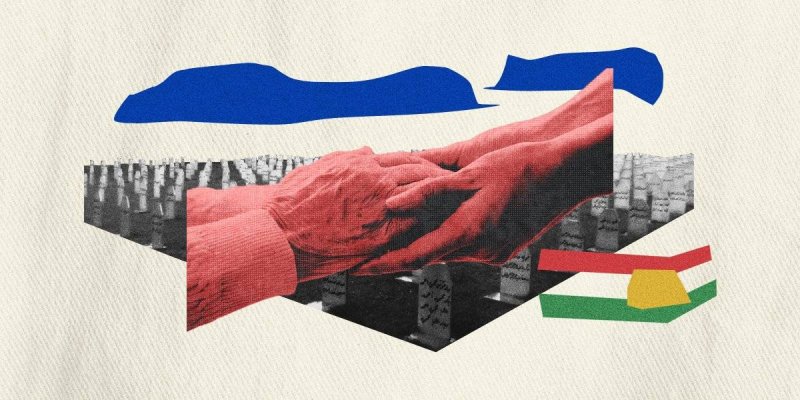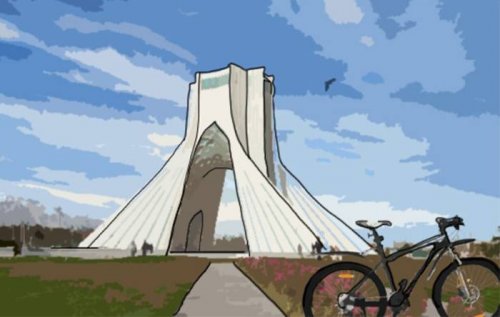“My Kurdish name is Khalil, my Iranian one is Muhammad Amin. But you can also call me Yusuf. The missing Yusuf who will reunite with his mother after a 31-year absence.”
The quiet man was sitting in front of the camera, surrounded by reporters from state media. He would soon embrace his elderly mother, who had lost him for decades, in a scene that would exemplify Kurdish suffering.
The eight-year Iran-Iraq war (1980-1988) is estimated to have taken the lives of more than a million people, leaving millions more injured and displaced in its wake. As the war neared its end, a Kurdish city lying 14 kilometres inside the Iraqi side of the border would mark its name in history, leaving an indelible scar in future relations between Iraq, Iran, and the Kurdish minority caught in the middle.
“My Kurdish name is Khalil, my Iranian one is Muhammad Amin. But you can also call me Yusuf. The missing Yusuf who will reunite with his mother after a 31-year absence.”
On March 16, 1988, the city of Halabja was preparing itself for the annual festivities of the Persian new year – Nowruz, celebrated worldwide by a host of communities, including Kurds – when the Iraqi Army launched chemical attacks which killed 5,000 people and injured 8,000 more. Iranian media was first on the scene, playing a crucial role in bringing the news of this act of genocide to the world.
Even at that stage of the war, Iran’s population didn’t view the latest crime by Saddam Hussein’s regime as simply another sad story in the everyday news cycle, for the massacre at Halabja brought back fresh memories of the rockets and missiles the Iraqi dictator had rained over Iranian cities not so long ago.
“What if we were in their place?” says Hushang, now 65 years old. “I was a father of a small girl in those days and we had started to adapt to this horrible war, when the television started broadcasting unbelievable scenes. Bodies in the streets of Halabja and at the doors of the homes there. Are they asleep? How did Saddam do it? Those scenes could never leave my mind. Women speaking Kurdish running from death, and men whose faces had turned into helpless statues. A smell of death reeked from the television.”
Iran’s population sympathised with Halabja – which until two days before the attack had been under the control of the Iranian army. Many Iranians rushed to aid in the relief efforts, making donations and taking care of the orphaned children whose families had been killed during the war. Members of the Iranian army were the first to enter the city following the attack – accompanied by emergency medical crews who transported the injured to hospitals in Tehran, Shiraz and Mashhad. Refugees were evacuated and distributed across camps along Iran’s border cities.
Stories of adoption
For all its horrors, the tragedy of Halabja would produce illustrious stories of heroism and generosity in the years ahead; serving as testament to how the best of humanity can emerge even during its darkest moments. The story of one Iranian doctor, Heshmatullah Waisy, gained particular acclaim (to the extent of being taught today in the primary school curricula of the Kurdistan Regional Government).
A doctor from Iran’s Kermanshah province, Waisy was spurred to action after hearing news of the attack – subsequently helping to save 17 babies found among the corpses of their families, the oldest only a year old.
Recounting his memory of the experience, Waisy says: “I saved 17 children and moved them with the help of a volunteer team to Kermanshah. They were then moved to other cities to get treatment and I didn’t know their fate. I was able later to get in touch with three families which adopted three of the children, while five others were killed after struggling with a disease that was identified after DNA testing. I wasn’t able to reach the rest.”
In all, Iranian emergency teams transported up to a hundred children to hospitals in what were described as “turbulent” circumstances; they were separated from their mothers and fathers, who received treatment elsewhere. Some parents would later succumb to their injuries, while others survived – without knowledge of their children’s fate.
Muhammad Amin – or ‘Yusuf’ – was seven months old when he was found alive by rescue teams, surrounded by the corpses of Halabja’s perished. He was first transported to the city of Kermanshah before being moved again to Shiraz for treatment. It was there that a member of Shiraz’s relief and emergency service refused to leave baby Yusuf to face his unknown fate, and decided to adopt him instead (Iranian law allows the adoption of children under the supervision of certain agencies).
‘Muhammad’ would survive with a new father and mother, with whom he would live for 31 years in Shiraz.
The eyes of the boy of Kurdish origin – now in his early thirties – filled with tears as he spoke of his Iranian family: “I was adopted by the family of Al-Sayed Ismaili, and I was raised among them as if I were their own. They never hesitated for a moment in giving [their kindness], and everything I am today I owe to them.”
Muhammad would go on to study law at an Iranian university, before specializing in medical law in the city of Qom. He has been married for five years and has a child.
Muhammad’s story of survival would take a further remarkable turn in 2016 when an Iranian newspaper published an important announcement by Ali Uthman, the head of an Iranian committee charged with searching for the missing survivors of Halabja. The newspaper ad called on Iranians to help the committee return Halabja’s missing survivors to their families, while thanking them for hosting those who had been saved over all the preceding years.
Genetic testing and the road to discovery
According to Muhammad Tolayi, director of the Noor Centre for Genetic Testing in Tehran, though 100 Kurdish children were received by Iranian families following the Halabja massacre few accurate records were collected. However, with the end of the war, committees were established to follow up on the fate of the surviving children, a process that was expedited after the fall of Saddam’s regime in 2003.
Joint committees were set up with officials in Iraq’s autonomous Kurdistan region, and DNA samples were taken from 114 families from Halabja to compare with the samples of any missing survivors.
After the reunification efforts were announced, Muhammad submitted his adoption papers to the Noor genetic centre in the hope of finding his Kurdish family. When the results returned he was informed that he was the fourth child of a family of eight still living in Halabja – a family which was still unaware of the fate of its missing son.
With support from the Noor centre and the Red Cross, Muhammad submitted a request via the Iranian and Iraqi foreign ministries to help him find his family.
As he approached his Iraqi birth mother for the first time in 31 years, the interpreter immediately stepped aside – allowing the Kurdish-speaking mother and Farsi-speaking son to say the words “I love you”, “I missed you” to each other.
On Feb 21, 2018 – less than a month before the anniversary of the massacre – Muhammad embraced his now-elderly mother. He would have to memorise her face as a man.
Muhammad would be the third missing survivor to reunite with his family after undertaking genetic testing.
Unfortunately, Muhammad’s father failed to make the same miraculous escape as his son – passing away 20 years ago from complications he sustained during the chemical attack.
Alipoor’s story
Muhammad Amin’s story differs considerably from that of his compatriot Alipoor – one of the most famous recorded incidents of Kurdish reunification which took place in 2009. While Muhammad returned to his life in Iran after finding his birth family, Alipoor tragically would lose his only adopted relative, an Iranian women who raised him for 22 years in eastern Iran.
“Four months after the accident which took the life of my adopted mother, I felt estranged and alone” he says. “I realised that the moment of return to Halabja had arrived.”
Unlike Muhammad however, Alipoor didn’t expect to find his mother waiting for him: official papers declared him the only surviving member of the family. Instead, he was looking for any distant relatives, and perhaps, an opportunity to fill the void of his adopted mother’s death in his unknown homeland.
In 2009, two decades after the 1988 massacre, 58-year-old Fatima Muhammad Saleh was still living alone in Halabja, after having lost her husband and six children in the chemical attack. That’s when a young, ‘estranged’ Kurdish man arrived in the city, asking questions about his relatives. A city that still awaits to this day, and every day, the return of some of its long-lost sons from the past.
After announcing himself, five Kurdish families rushed to insist that Alipoor was their son, and a strange atmosphere of competition over the refugee survivor ensued. Eventually, genetic testing revealed what Fatima perhaps never dreamed of: the man in his twenties standing in front of her was the baby she had lost on the day of the massacre. Perhaps a sign that she had never lost faith – or equally, that she had long since given up – she described his return as a “gift from God.”
The first port of call for Halabja’s searching families has been Iran, with everyone wishing for the return of the missing to their families, though Iranian figures don’t match those of international organisations.
The Iran-Iraq War ended long ago, and Saddam Hussein not so long after it. But the ‘chemical scar’ of 1988 remains entrenched in the Kurdish DNA, with the stories of Halabja’s diaspora constituting some of the most tragic in recent memory – even in a region which is known for its tragedies.
Nonetheless, there should be little illusion about the difficulties that still lie ahead in this process. And what of the Iranian families, who devoted so much of their lives to bring up the survivors? And what of the 100 Kurdish survivors, who can’t speak their mother tongue, and whose identities as a whole were torn and lost in the war, scattered in the official records?
The Iran-Iraq War ended long ago, and Saddam Hussein not so long after it. But the ‘chemical scar’ of 1988 remains entrenched in the Kurdish DNA, with the stories of Halabja’s diaspora constituting some of the most tragic in recent memory – even in a region which is known for its tragedies.
But the events of history can’t be changed, and three decades ago 100 seeds of Kurdish sorrow were planted in Iran, cultivated under the loving of humanity’s kindest to grow into resilient flowers; some stories of which have been written, and others which still wait to be told.
Raseef22 is a not for profit entity. Our focus is on quality journalism. Every contribution to the NasRaseef membership goes directly towards journalism production. We stand independent, not accepting corporate sponsorships, sponsored content or political funding.
Support our mission to keep Raseef22 available to all readers by clicking here!






Join the Conversation
Anonymous user -
1 day agoUn message privé pour l'écrivain svp débloquer moi sur Facebook
Anonymous user -
1 day agoالبرتغال تغلق باب الهجرة قريبا جدااا
Jong Lona -
2 days agoأغلبهم ياخذون سوريا لان العراقيات عندهم عشيرة حتى لو ضربها أو عنقها تقدر تروح على أهلها واهلها...
ghdr brhm -
2 days ago❤️❤️
جيسيكا ملو فالنتاين -
4 days agoجميل جدا أن تقدر كل المشاعر لأنها جميعا مهمة. شكرا على هذا المقال المشبع بالعواطف. احببت جدا خط...
Tayma Shrit -
6 days agoمدينتي التي فارقتها منذ أكثر من 10 سنين، مختلفة وغريبة جداً عمّا كانت سابقاً، للأسف.